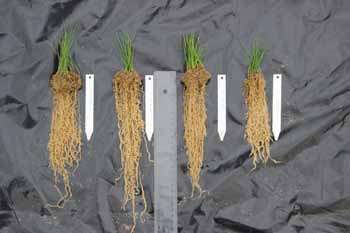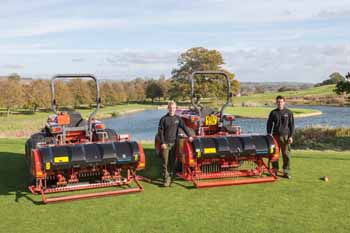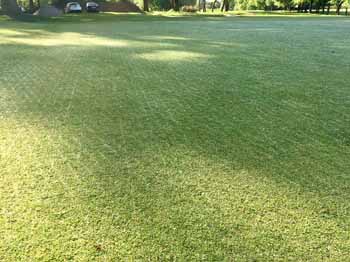What aeration and overseeding practices should we deploy this autumn?
Related Articles
Now that the summer is over, greenkeepers are working harder than ever to deal with the ramifications of such a prolonged dry period.
The long dry summer of 2018 may well enter the history books yet for golf course managers it is business as usual as autumn gets into swing and the normal seasonal tasks beckon.
For turf managers, trying to balance quality turf surfaces with the ever-increasing playing expectations of the golfers means getting a maintenance programme in place to ensure year-round golf is vital.
Ian Lauder, northern territory manager for Charterhouse Turf Machinery, stresses the importance of aeration to rectify drainage problems caused by compacted soil structures with work done throughout the autumn crucial to delivering improved results through the winter period.

“Aerated turf is less likely to be compacted, ensuring better drainage and allowing roots to penetrate deeper where nutrients can contribute to a stronger, healthier plant,” he pointed out.
As the weather returns to seasonal normality, care should be taken if the greens are soft and the plant is vulnerable not to use excessive weight or force with any applications you may consider employing.
“As soon as you can get a machine onto the surface, without causing issues, aeration should be conducted,” said Ian.
Lighter Verti-Drains, such as the 1513 or 1517 from Charterhouse, can be mounted behind a small compact tractor and deliver the results required to keep the surface free draining. It can also help to link up with the deeper aeration work done over the winter.
Next season, if a wet spring looks to be on the cards, the linear aeration provided by the Redexim Verti-Quake is a good alternative.
The rotary motion, combined with the forward speed, sets up a wave action which helps decompaction to take place. However, it should be used with caution in dry conditions as slit lines can shrink and open up if the ground is too dry.
Poorly drained soils restrict microbial activity, which can in turn reduce the rate organic matter decomposes. This results in anaerobic conditions which encourage diseases and / or a build-up of thatch. If the green is suffering with accumulations, a scarification programme will help to reduce thatch levels and increase the O2 within the organic matter vicinity to help aerobic microbes break down the thatch.

The Graden can remove excess organic matter and allow the operator to backfill with a combination of sand and / or seed to immediately give a surface that is stable and firm
“Scarifying with the Graden Contour Sand Injection (CSI) Unit removes excess organic matter and allows the operator to also backfill with a combination of sand and / or seed to immediately give a surface that is stable and firm. Using the Graden CSI along with the Verti-Drain or Verti-Quake gives a concise and complete aeration and renovation programme for the entire soil profile and a better growing medium for fresh, strong and vibrant re-growth,” Ian added.
The UK and many European countries suffer with shorter day lengths and lower soil temperatures at times when golf is still played at a high level – principally late autumn, winter and early spring. John Hughes of DLF Seeds explains how rigorous testing and development has seen the development of seed varieties that will germinate and grow at lower temperatures.
“While we cannot cheat nature or beat true winter weather, seed breeders such as DLF have been working on new developments to extend seeding windows – one of these being developments in ryegrass,” he said.
“In 2012, DLF introduced ‘Tetraploid Ryegrasses’, which characteristically provide rapid establishment at low temperatures thanks to their larger seed size. This is primarily due to the larger number of chromosomes within the cell nucleus.” DLF’s 4Turf tetraploids Double and Fabian are used in two Johnsons Sport Seed ranges for tees and fairways.

Meanwhile, modern diploid ryegrasses are fine leaved, tolerant of close mowing and can establish at temperatures below the threshold for fescue and bents. Because of these qualities, they have become popular for tee and fairway use, especially on parkland courses.
Looking ahead to next spring, John pointed out that many of the courses in the UK were built for summer play and as such have greens constructed to hold moisture: “The majority of grasses used in golf establish and function at relatively high temperatures so while the temptation may be to oversow as soon as the snow subsides, fortune favours the patient.”
With budgets tight, it may be tempting to prioritise those all-important greens leaving the sowing of any slightly worn areas until later. The problem is that if left, those small worn areas can quickly grow. Once the grass surface is gone, soil particles can quickly splash up onto surrounding plants, which in turn reduces the ability of the grass to photosynthesise; something that’s very important early in the year when light levels are already low. This then causes the surrounding plants to thin out more rapidly, therefore increasing the size of the problem. Timely oversowing prevents the damage spreading and reduces the chances of weed grasses like poa annua getting a foothold.
Over at Wiedenmann, the Terra Spike GXi8 HD continues as its UK’s best-selling aerator from the fleet of 11.
Matt James, course manager at Cumberwell Park GC, who oversees five nine-hole courses at Bradford-on-Avon, has two GXi8s and knows the model well. Some form of aeration is carried out at the Wiltshire club every two to three weeks.

Wiedenmann’s Terra Spike GXi8 HD at Cumberwell Park GC
The Cumberwell team aerate tees at least once in the winter with 12mm solid tines varying depth and heave as conditions allow. A handful of areas displaying signs of more compaction might be given a second run as spring approaches. During March, hollow coring takes place using 10mm coring tines. Again repetition may be carried out. Over the summer the tees get lightly pencil tined with several passes. Cumberwell’s broad USGA greens are tined twice in the winter with 12mm solid tines and then throughout the year receive maybe half a dozen passes with 8mm tines.
Increasingly, the Cumberwell Park team has been introducing multi-tine heads for finer work and for coring throughout the year. The GXi8 HD can be fitted with multi-tine holders on all eight legs, each solid multi-tine head holding up to twelve 5mm needle tines while each coring multi-tine head takes six tines per head with a coring diameter from 6mm.
“We certainly vary the tines. With the Wiedenmann we can always achieve the depth which is important. In the past we tried fitting tining units on our greens’ mower but couldn’t get the necessary depth. Now we get finite control from just a few millimetres all the way to 250mm depending on what tines are fitted,” he said.
Ecosol Turfcare, operator and supplier of the Drill n Fill, recommends greenkeepers use the legendary aerator on poorly draining greens during spring or autumn for maximum impact.
The ability to gently fold back the turf, drill down to 30cm with a grid of drills, take out the spoil and backfill it with either pure kiln-dried sand or a mix of sand and soil amendment, has numerous benefits for golf greens that are slow to drain, retain surface water, have thatch or blackgrass, poor grass growth and compaction. The ducts created last for over a year, allowing surface water to percolate off the surface, through obstructions caused by thatch or compaction and into the rootzone and drainage layer. Soil amendments, such as Ecosol’s zeolitic Sportslite, impart their benefits to plant’s roots, allowing improved uptake of nutrients; increased cation exchange capacity; better germination, drainage rates and levels of plant-available water; and reduction compaction and leaching.
The system is particularly beneficial for old clay-based golf greens with push-ups and even for USPGA greens where too much sand or fines have been used in their construction. Some clubs also like to use Ecosol’s Graden, a liner aerator which rips through thatch and can also be backfilled with sand.
After Drill n Fill, greens can be back in use in two hours and will usually result in fewer greens’ closures during the winter months.
“We are just off to The Netherlands with four machines,” said managing director Bretton King, “to ‘Drill Fill’ Kennemer GC, something we have been doing on a rolling programme for many years and they are always delighted with the results.”
Greenkeepers using Forefront Greens mixture from Germinal have been seeing great results.
Forefront Greens is made up of three bentgrass varieties – 35 per cent AberRegal (browntop bent), 35 per cent AberRoyal (browntop bent) and 30 per cent 007 DSB (creeping bent).
Richard Brown, amenity sales manager, said: “Unlike older creeping bent varieties, 007 DSB does all of this with a lower requirement for water and nutrients. This means that, for the first time, a creeping bentgrass can be successfully blended with high quality browntop bent varieties to deliver an added-benefit but low input seed mixture.
“As such, Forefront Greens is the perfect solution for progressive greenkeepers who are currently managing browntop bents, but who are seeking extra performance without the need for additional management inputs.

Forefront Greens – ‘the perfect solution for greenkeepers who are currently managing browntop bents but who are seeking extra performance without the need for additional management inputs’
“Overseeding with bentgrass works well whenever the soil temperature is favourable, essentially between April and September in the UK. Although a full overseed once a year when temperatures are most favourable is desirable, we are seeing greenkeepers have good results conducting two lighter overseedings (each 2.5g/m2) at different times in the season, perhaps once in spring and once in late summer.
“More unusual but worthy of discussion is the idea of dormant seeding of bentgrass; sowing in the autumn or early winter in order for plants to emerge in the spring. We have seen evidence of this working well in the UK, with 007 creeping bentgrass worth considering if the traditional overseeding opportunity is missed or if you are getting limited success at traditional times and suspect it is due to play and wear leading to high seedling mortality. The technical advantage of dormant seeding is that seedlings that do emerge in the spring do so when the number of rounds being played is low.”

























